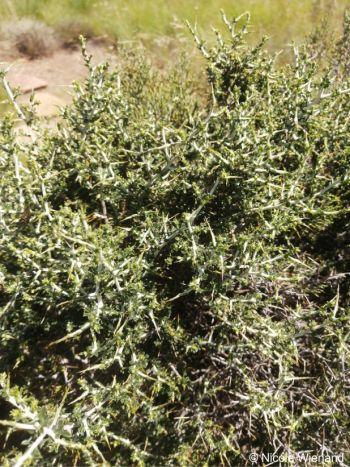Melolobium candicans
Melolobium candicans (E.Mey.) Eckl. & Zeyh.
Family: Fabaceae
Common names: honey bush (Eng.), heuningbossie, stroopbossie, voëltjie-kan-nie-sit-nie (Afr.), sehlabane (Sesotho)
Introduction
A widespread, thorny, aromatic, dwarf shrublet with divaricately branched, white-velvety stems ending in sharp spines, yellow flowers and hairy pods.

Description
Description
A rigid, spiny shrublet 0.3 to 0.5 m high. The stem is densely covered with short white hairs that gives them a white, velvety appearance. The leaves are sticky, divided into three oblong leaflets and covered with white hairs. It produces yellow flowers that fade to reddish-orange, borne at the ends of branches from midwinter to midsummer (July to December). It has narrowly oblong, straight, very hairy, dehiscent fruit pods, with up to five seeds.

Conservation Status
Status
According to the Red List of South African plants website, the conservation status of Melolobium candicans is assessed as Least Concern (LC), meaning it is not under threat in its natural habitat.
Distribution and habitat
Distribution description
Melolobium candicans is endemic to southern Africa, occuring in South Africa, Namibia and Lesotho. It grows well in a wide range of habitats, on stony ridges kopppies and riverbanks, in grassland and Karroid scrub. In South Africa it is distributed in Eastern Cape, Free State, North West, Northern Cape and Western Cape Provinces.

Derivation of name and historical aspects
History
The genus name Melolobium derived from Greek, melos meaning ‘a joint’ and lobium meaning ‘pod or capsule’, referring to the joint-like constrictions between seeds. It is a poorly known genus with 15 species of small shrubs or perennial herbs native to southern Africa. The species name candicans, means ‘becoming white’, ‘shining white’ and ‘hairy’, this obviously refers to the stems that are covered with short white hairs.
Species placed under Melolobium were previous included under other genera since the genus Melolobium did not exist and this species was previously known as Dichilus candicans E. Mey. The generic concept of Melolobium was established in 1836 by Christian Friedrich Ecklon, who was a collector and researcher of plants in South Africa, and Karl Ludwig Philipp Zeyher, who was a botanical and insect collector who collected extensively in South Africa. Recent DNA analysis supports the monophyly of this genus, indicating that they all arise from a single common ancestor.

Ecology
Ecology
The copious nectar attracts bees and wasps. The seeds are thought to be dispersed by being expelled when the pods split open (dehisce), but it is possible that they are also spread by animals. The plant is very spiny and strongly aromatic, which serve as protective mechanisms against trampling and browsing by herbivores.

Uses
Use
Decoctions and infusions made from the leaves and stem are drunk to treat tuberculosis. A mild tasting, light lemon coloured honey is produced by bees foraging on these plants. The spiny branches can be used to keep the mice away. The plants have been suspected of causing poisoning in small stock, but nothing definite is on record.

Growing Melolobium candicans
Grow
Propagation can be done by seeds. Sow seeds in autumn in a well-drained medium. This plant should be grown in a position in semi-shade to full sun. Usually found growing wild in arid regions, it is drought-tolerant and resistant to frost. Some companion plants that Melolobium candicans could be planted with include plants such as Euphorbia mauritanica, Felicia filifolia, Cotyledon flanaganii and Eriocephalus racemosus.
References
- Brown, J.M.M. & De Wet, P.J. 1967. A survey of the occurrence of potentially harmful amounts of Selenium in the vegetation of the Karoo. Onderstepoort Journal of Veterinary Research 34(1):161-218.
- Clarke, H. & Charters, M. 2016. The illustrated dictionary of southern African plant names. Flora & Fauna Publications Trust, Jacana, Johannesburg.
- Cock, I.E. & Van Vuuren, S.F. 2020. The traditional use of southern African medicinal plants for the treatment of bacterial respiratory diseases: A review of the ethnobotany and scientific evaluations. Journal of Ethnopharmacology 263.
- Johannsmeier, M.F. 2016. Beeplants of South Africa. Sources of nectar, pollen, honeydew and propolis for honeybees. Strelitzia 37. SANBI, Pretoria.
- Kesting, D. & Clarke, H. 2008. Botanical names: what they mean, wild flowers of the Cape Peninsula. Flora Documentation Programme, Friends of Silvermine Nature Area, Muizenberg.
- lorainevdb. 2016. Observation of Melolobium candicans, Mountain Zebra National Park, South Africa. iNaturalist. Online. https://www.inaturalist.org/observations/11283690
- Manning, J. & Goldblatt, P. 2012. Plants of the Greater Cape Floristic Region 1: the Core Cape Flora. Strelitzia 29. South African National Biodiversity Institute, Pretoria.
- Moteetee, A. & Van Wyk, B.-E. 2006. A revision of the genus Melolobium (Genisteae, Fabaceae). South African Journal of Botany 72:51-98.
- ortie75. 2023. Observation of Melolobium candicans, Kamiesberg, Garies. iNaturalist. Online. https://www.inaturalist.org/observations/179519558
- Raimondo, D., Von Staden, L., Foden, W., Victor, J.E., Helme, N.A., Turner, R.C., Kamundi, D.A. & Manyama, P.A. (eds) 2009. Red list of South African plants. Strelitzia 25. South African National Biodiversity Institute, Pretoria.
- Retief, E. & Meyer, N.L. 2017. Plants of the Free State inventory and identification guide. Strelitzia 38. South African National Biodiversity Institute, Pretoria.
- Stirton, C. 2009. Observation of Melolobium candicans, Nuwekloof Pass to Hartebeesriver https://www.inaturalist.org/observations/42419987
- Wienand, N. 2022. Observation of Melolobium candicans, Bo-Karoo, South Africa. iNaturalist. Online. https://www.inaturalist.org/observations/107820335
Credits
Lufuno Nenungwi
Free State National Botanical Garden
January 2024
Acknowledgements: Images by lorainevdb, ortie75, Charles Stirton and Nicole Wienand, from their observations on iNaturalist.
Plant Attributes:
Plant Type: Shrub
SA Distribution: Eastern Cape, Free State, North West, Northern Cape, Western Cape
Soil type: Sandy, Loam
Flowering season: Spring, Early Summer, Winter
PH: Acid, Neutral
Flower colour: Yellow, Orange
Aspect: Full Sun
Gardening skill: Average
Special Features:
Horticultural zones









Rate this article
Article well written and informative
Rate this plant
Is this an interesting plant?
Login to add your Comment
Back to topNot registered yet? Click here to register.